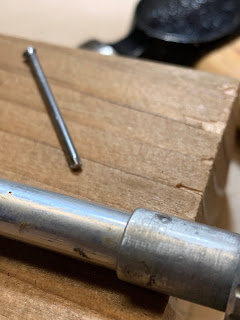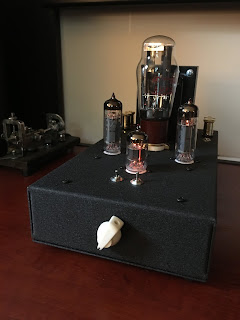This will lead to Easter Seals, so wait for that.
I was part of the original March of Dimes campaigns that were a response to the polio epidemics. I was on radio and TV broadcasts that harangued people to give their dimes to support research to design, produce and distribute a safe and effective polio vaccine. (This may sound familiar to people alive and cognizant of the events of 2020... even though there was no real reliance on charity donations in 2020. But you get the idea.)
The first widely available polio vaccine (the Salk vaccine) came into wide use in 1955. That was too late for my mother and 3-year-old cousin, neither of whom survived. I was infected, but survived. But not without consequence. Prior to her death, my Mother thought I had a flu. It wasn’t. Certainly not the “China flu.”
The polio virus attacks and kills nerve horn cells. These cells of the nerve system communicate with the motor nerves, the nerves that activate muscles, distinct from the nervous system that transmits feelings such as pain or pleasure.
I haven’t studied this, but for some reason a polio infection can follow a *path* ... for some it may be one arm, for others, two legs, for some one of each on one side, for others an appendage plus an involvement of the throat - a restriction of the ability to swallow, however mild, is not uncommon. For me it was primarily one leg - the left leg.
For some of the early years this meant that I just needed a brace on the left leg - a brace attached to the shoe that reached mid-calf. Being the overachiever that I am (striving to over-achieve is an almost universal characteristic of polio patients,) I found ways to break the brace without even trying. Restrict me? Hell no, I can do anything!
Eventually I gained enough weight (lots of meat and mashed potatoes were a wonderful aid to weight gain) so that I needed something more than a leg brace. Well, Dad eventually gave up welding the brace to repair it. (See footnote 1) With the weight gain came falling. I attempted to mitigate that by walking right next to walls, balancing myself, as I navigated school hallways. This was only partially successful. Yes, it reduced the number of falls, but when I DID fall, much of the time my right knee would end up smashing into the wall - in this case the hallway walls were brick, not forgiving. (See Footnote 2)
At some point my medical care team decided I needed a crutch. Initially Dr. McNutt (his real name, and pretty appropriate - in a good way) had predicted I would never walk at all. What did he know? Now I was fitted with a Canadian (forearm) crutch. It was made of aluminum (light weight - yay!) and featured adjustments for both overall length and distance between hand grip and forearm cuff. Perfect, eh?
Yup, it worked. Well, except that I USED IT “WRONG”! Normally someone with a weaker leg uses a crutch on the opposite side. The stride is “strong leg side” then “weak leg side accompanied by crutch on strong side.” It sort of makes sense. But when the “weak” leg can actually bear NO weight (my case once I reached a certain weight,) that doesn’t work. You need to bear weight on the weak side, no matter what. So I used the crutch on the weak side, even though medical science said that was “wrong.” Worked (and works) for me. There are other aspects as to exactly how I orient the crutch in respect to my body and left leg, but it’s rather difficult to explain in words, so I won’t. Just leave it that that is also “wrong.” But it works.
What does this have to do with Easter Seals? I’M GETTING THERE. I’m not into the whole brevity thing, dude.
When you are young and very different, especially before society sort of decided that the disabled community suffered discrimination and deserved at least a modicum of justice and equal access, things hurt. But when that discrimination, that hurt, is “normal”, when it is accepted as just the way it is, you internalize it. After all, it’s somehow justified, just the way it is, right? Without realizing it, you identify with your community. For the most part, that community looked like you - maybe the disability was totally different, but still you saw yourself in those who, like you, went to “special” schools, where classrooms were filled with others with polio, cerebral palsy, seizures, impaired vision up to and including blindness, mental deficiencies that could even manifest as absolutely hilarious cray-cray trains of thought and outbursts. (For example Karl Flinschpach really thought he was a Diesel engine. I kid you not; it was hilarious getting him to say “I’m a diesel!”) You get the picture.
Instead of being some weird and absolutely frightening hell scape, this was your unbelievably eclectic, comical and entirely loveable family. If you were lucky (I was) your biological family understood this and not only accepted the other “freaks” but took you to their homes and parties on weekends so you could have human, normal social interaction. I mean, who the fuck defines “normal”, anyway?
Enter ... Easter Seals. The dominant society tries to define what is normal; thus the activities they program into their group interactions exclude me and my peers. We weren’t exactly picked first, second, or even next-to-last for the pickup baseball game. Rugged hiking? Fuhgettabowtit - the invitation for that party never arrived. So you’re lucky you didn’t even know about it - until you learned about it after the fact as the in crowd kids could only talk about how cool it was. About how David finally got to first base with Sally. How extraordinary the next activity was going to be - they’d probably even forget about the last outing, and David would get even further.
Don’t get me wrong - I had great friends, peers, who cared about us, who included us as much as they could, even went out of their way. These people are still my friends, to this day. That’s many, many days later.
But still, to be left out by default, just out of habit, wasn’t nurturing. Not their fault - they really didn’t know how to do better; no one had taught them.
But Easter Seals did know how to do better. In that era they supported and organized Summer camps for us. In my case, the heroes that staffed those 2-week Summer camps came from near and somewhat far. Their names were Clifford E. “Pop” Horton (the first prime mover in our area,) Dale and Jo Spurgeon, Charlotte Koehler, Prudence Washburn, Mimi Olds and Harry O. Jackson. Plus many, many others whose names I either can’t remember or only partially remember. (One female counsellor, had the last name of Stone I can’t remember her first name ... though I clearly remember her face and body. She nearly seduced me when I was a young teen and we were alone together in the cabin - it’s probably good I don’t remember her full name. Sadly, there was no denouement. As in nudity.)
It was at Easter Seals camps that we were all physically “equal” regardless of our wildly differing abilities. Some could barely tread water in their PFDs, but were deliriously joyful nearly drowning. Counsellors with laser vision (ironically lasers were invented much later,) kept watch so that Easter Seals would not be sued. I was fortunate - I was able to swim well, learned to row a boat, then paddle a canoe (that was a BIG graduation and point of pride,) then sail a small Sunfish or Dagger, then actually sail a fucking aluminum Grumman canoe using a paddle as a rudder and my teeth to work the sheet controlling the sail. Try THAT, non-gimp people.
Decades later, when one of my employers routinely promoted Easter Seals donations annually, I would bug my co-workers to give. I probably annoyed them more than usual - which is saying a lot. Since then I have not followed Easter Seals. The last I remember they had shifted their primary focus to research into and prevention of birth defects. I unreservedly support this. Each new born deserves to live and grow without stupid handicaps and hurdles. I’m pretty sure they still support camps and activités for those not so lucky, whether by birth anomalies or post-natal disease or accident.
If you’ve made it this far (believe me, this is the short version - try being attacked by a dog when you can’t run!) thank you. Share it out. If you didn’t make it this far, well, you don’t know who you are right? And WTF, man?
Peace.
Footnotes
1. Dad grew up right next to railroad tracks. It was the era of steam and Dad especially loved steam. Whenever he heard the whistle of an approaching locomotive he would run through the house and out the front door. The screen door had no latch, so he could just burst through and the door’s spring would slam it close. Grandpa Dunbar decided to install a simple latch to “upgrade” the house to a more modern, civilized property. He showed Dad how to open the door and warned Dad he could no longer just burst through. As you can guess, in Dad’s heightened excitement when the next whistle blew, he burst through the door, breaking the latch. Grandpa quietly repaired it and gave Dad another talk. Next whistle? Same thing - run, bash, broken latch. Grandpa didn’t say a word. He just quietly removed the latch.
2. After a move to a new city, I found a new general practitioner for my health care. On one visit I described to my doctor how from time to time my right knee would seemingly just give out, and down I would go. I described how I used to hit that knee against the bricks of the hallway walls in public school, and that I thought I might now be having issues with the knee. Doc took a look and didn’t feel anything amiss. An X-ray was in order. But he also examined the rest of the leg and declared “You have no quads!” So unbeknownst to me, right leg had been affected as well. Which meant I walked with my right calf and butt muscles, and my left arm. Dr. Blair is a good man, and thorough, Jeffrey.





